Stebold
The Earthquake That Will Devastate the Pacific Northwest. When the 2011 earthquake and tsunami struck Tohoku, Japan, Chris Goldfinger was two hundred miles away, in the city of Kashiwa, at an international meeting on seismology.

As the shaking started, everyone in the room began to laugh. Earthquakes are common in Japan—that one was the third of the week—and the participants were, after all, at a seismology conference. Then everyone in the room checked the time. Seismologists know that how long an earthquake lasts is a decent proxy for its magnitude. The 1989 earthquake in Loma Prieta, California, which killed sixty-three people and caused six billion dollars’ worth of damage, lasted about fifteen seconds and had a magnitude of 6.9. When Goldfinger looked at his watch, it was quarter to three. It was March. Oh, shit, Goldfinger thought, although not in dread, at first: in amazement. For a moment, that was pretty cool: a real-time revolution in earthquake science.
A Dynamic Interpretation Of The Philidor. It’s strange how people often complain about their lack of opening knowledge when there are so many interesting sidelines in which it’s easy to be an expert.

And when you mention such possibilities the usual reaction is that they can’t possibly be good, meaning that because there aren’t being played at super-GM level. This is why restaurants sit their first customers next to the windows. The following game shows British Master John Littlewood using the so-called Larsen Variation of the Philidor (1.e4 e5 2.Nf3 d6 3.d4 exd4 4.Nxd4 g6) but Larsen didn’t play it much whereas Littlewood used it in literally hundreds of games. And he brought off some spectacular wins with it, such as the following one: [Event "4th EU Championship"] [Site "Liverpool ENG"] [Date "1973"] [Round "1"] [White "Sherman, David"] [Black "Littlewood, John Eric"] [Result "0-1"] [ECO "C41"] [Annotator "Nigel Davies"] [PlyCount "38"] [EventDate "2008.09.09"] [EventRounds "10"] [EventCountry "ENG"] 1. e4 e5 2.
People Are Freaking Out After The "New Yorker" Warned An Earthquake Will Likely Someday Destroy Seattle. Did The New Yorker's Earthquake Article Scare the Crap Out of You or What? - Fault Lines - Curbed Seattle. In Seattle, A Calmness Before The 'Really Big' Earthquake Predicted In Recent New Yorker Piece. SEATTLE -- Catastrophe will befall this lovely city, with its seaside Ferris wheel and shimmering office towers rising lazily above a glittering sound.
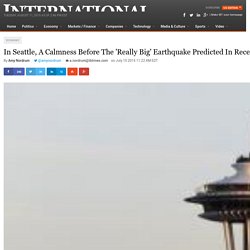
And it could happen at any moment.
Assessing the Probability of a Massive Cascadia Earthquake
Watching the waves spill onto the beach in Clatsop County, Oregon, it's easy to forget that the nearby houses are doomed.
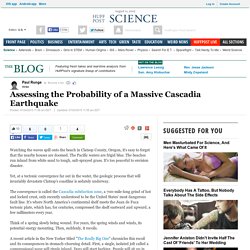
The Pacific waters are frigid blue. The beaches run inland from white sand to tough, salt-sprayed grass. It's too peaceful to envision disaster. Yet, at a tectonic convergence far out in the water, the geologic process that will invariably devastate Clatsop's coastline is sedately underway. The convergence is called the Cascadia subduction zone, a 700-mile-long grind of hot and locked crust, only recently understood to be the United States' most dangerous fault line. Think of a spring slowly being wound.
‘Everything west of I-5 will be toast’? Local experts react to article depicting huge quake in Northwest. SEATTLE — Those living in the Northwest know the next big earthquake could happen at any time.
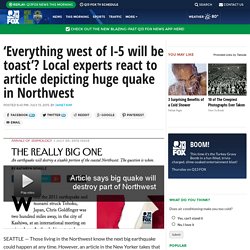
However, an article in the New Yorker takes that threat a step further, detailing what will happen when it does hit. Experts say older buildings and structures in Seattle, like the Alaska Way Viaduct, would be most vulnerable during an earthquake, but they don’t believe the devastation is going to be like anything depicted in the movies. The New Yorker article discusses the possibility of a major earthquake and its impact, quoting FEMA’s regional director, Kenneth Murphy, as saying, “Our operating assumption is that everything west of Interstate 5 will be toast.”
Buying into the earthquake scare is almost too expensive - Ron and Don. It will take a lot more than a $30 survival kit to prepare for the big earthquake.
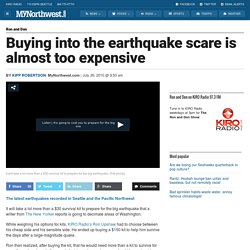
(File photo)
The New Yorker earthquake article unleashes tsunami of social media: 8 takeaways. Leave it to The New Yorker to publish the definitive treatment of horrors bound to spring from a Northwest Cascadia subduction-zone earthquake and tsunami.
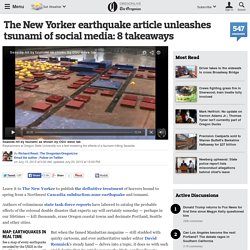
Authors of voluminous state task-force reports have labored to catalog the probable effects of the colossal double disaster that experts say will certainly someday — perhaps in our lifetimes — kill thousands, erase Oregon coastal towns and decimate Portland, Seattle and other cities. But when the famed Manhattan magazine — still studded with quirky cartoons, and ever authoritative under editor David Remnick's steady hand — delves into a topic, it does so with such vivid clarity that its article sweeps the Web, sending Tweets skittering across our region and the world. This week's article, entitled "The Really Big One," forces us to confront anew the Damocles sword suspended over us by a thread. 1.
How to Stay Safe When the Big One Comes. We’ll send you a reminder.
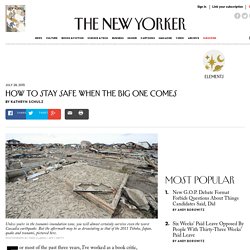
Your reminder will be sent For most of the past three years, I’ve worked as a book critic, which is not a job that affords me many opportunities to scare the living daylights out of my readers. (Authors, occasionally; readers, no.) But earlier this month, when a story I wrote about a dangerous fault line in the Pacific Northwest hit the newsstands, the overwhelming response was alarm. “Terrifying,” the story kept getting called; also “truly terrifying,” “incredibly terrifying,” “horrifying,” and “scary as fuck.” Novelists and screenwriters can terrify people, feel pretty good about themselves, and call it a day.
The Earthquake That Probably Won't Devastate Seattle. People Are Freaking Out After The "New Yorker" Warned An Earthquake Will Likely Someday Destroy Seattle. Megathrust quake! New Yorker scares the bejesus out of NW - The Big Science Blog. We love doing this, too!

By now you might have seen or been told about the New Yorker’s deep-dive into the coming megathrust earthquake along the Cascadia Subduction Zone that’s guaranteed to smash the hell out of everything west of the Cascades. If not, well glad we could jump onboard the fear train!
Will an Impending Earthquake "Devastate Seattle"? About That Terrifying <i>New Yorker</i> Article. While seismology may seem to take us somewhat afield from our usual concerns at Evolution News & Views, the manipulation of science in the service of some unstated cultural or philosophical agenda is very much on topic.
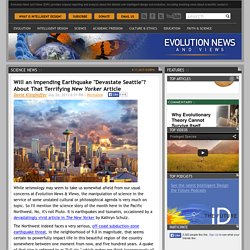
So I'll mention the science story of the month here in the Pacific Northwest. No, it's not Pluto. It is earthquakes and tsunamis, occasioned by a devastatingly vivid article in The New Yorker by Kathryn Schulz. The Northwest indeed faces a very serious, off-coast subduction-zone earthquake threat, in the neighborhood of 9.0 in magnitude, that seems certain to powerfully impact life in this beautiful region of the country somewhere between one moment from now, and five hundred years.
A quake of that size is referred to as "full-rip," which makes me think incongruously of a family friend of ours who was keen on knowing whose kids got into which colleges and on what kind of scholarship. Including me. That's a striking choice of words.
Corrections to the New Yorker Earthquake Story. Let me begin by saying I really hate social media.
The Five Scariest Takeaways From the New Yorker Article About the Earthquake That Will "Devastate" Seattle.
Seattle’s Old Buildings Unfit to Withstand Earthquake. Now What?
As cities across the U.S. concentrate on a future of resilience, Seattle is trying to figure out how it will handle the retrofitting of many of its brick structures that, if an earthquake hit, would crumble and likely cause many deaths. Many are calling for changes to be made before disaster strikes. “The sad thing is, I can tell you absolutely that immediately following the next big earthquake, after these old buildings fall down, there will be legislation passed to address this issue,” Eric Holdeman, former director of King County’s Office of Emergency Management, told the Seattle Times.
“We shouldn’t have to wait for a lot of people to be killed or injured to motivate us to take action.” The question isn’t whether or not these buildings are unsafe, it’s about who will pay for resilience. According to the Times, retrofitting an old “four-story, 20,000-square-foot apartment complex … means a bill between $400,000 and $1.2 million.” Seattle’s not alone.
Did Seattle earthquake report finally trigger an appropriate response? - Local News. "All the things" in people's day-to-day lives will be "gone for a while," Jefferson County Department of Emergency Management Program Manager Bob Hamlin told the Peninsula Daily News. (AP file photo)
If you think New Yorker’s earthquake story is scary, better read this. Although a terrifying read, the New Yorker piece shouldn't surprise Seattle Times readers. Science reporter Sandi Doughton wrote the book on the "really big one.
" Literally.
Editor’s note: We hosted an “Ask Me Anything” on Reddit on Tuesday to answer questions about quake science and preparedness.
The Earthquake That Will Devastate the Pacific Northwest.










